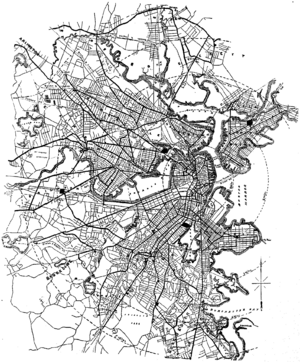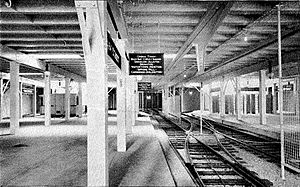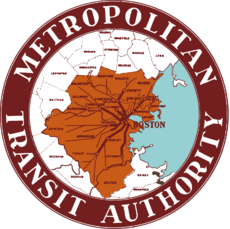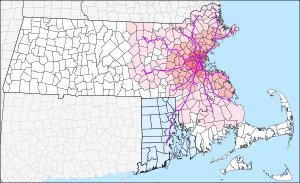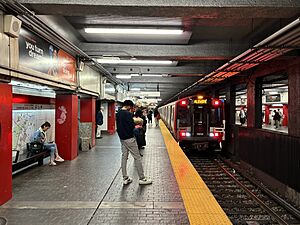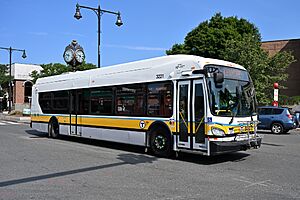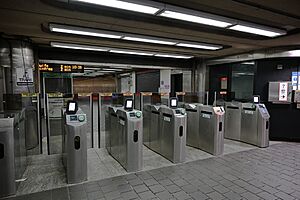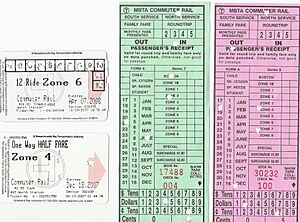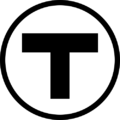Massachusetts Bay Transportation Authority facts for kids
Quick facts for kids Massachusetts Bay Transportation Authority |
|
|---|---|
 MBTA services sampling excluding trolleybus.jpg |
|
| Info | |
| Locale | Greater Boston, Massachusetts, US |
| Transit type |
|
| Chief executive | Phillip Eng |
| Headquarters | 10 Park Plaza Boston, Massachusetts 02116 |
| Operation | |
| Began operation | August 1964 (Predecessors date back to 1834) |
| Operator(s) |
|
The Massachusetts Bay Transportation Authority (often called MBTA or "the T") is the public agency that runs most public transportation in Greater Boston, Massachusetts. The MBTA's network includes the MBTA subway with three metro lines (Blue, Orange, and Red lines), two light rail lines (Green and Mattapan lines), and a five-line bus rapid transit system (the Silver Line). It also has MBTA bus services, a twelve-line MBTA Commuter Rail system, and several ferry routes. In 2024, the system had many riders, making it one of the busiest rapid transit and light rail systems in the United States.
The MBTA took over from many older public and private transport companies. Public transport in Boston started with commuter rail in 1834 and horse-drawn streetcars in 1856. Over time, these companies joined together and switched to electric power. The Boston Elevated Railway (BERy) took over in 1897 and built a subway system, starting with the Tremont Street subway in 1897. The BERy became public in 1919 and then became the Metropolitan Transit Authority (MTA) in 1947. The MBTA replaced the MTA in 1964, with a larger area to serve and fund suburban train services. The MBTA later became part of the Massachusetts Department of Transportation (MassDOT) in 2009.
Contents
History of Boston's Public Transport
For a long time, private companies ran public transport in Boston. These companies often had special permission from the state to operate. How transport developed also shaped where people lived and worked.
Early Railways
The first major railway, the private Boston and Lowell Railroad, started in 1830. It opened in 1835, connecting Boston to Lowell, a big factory town. This was the start of long-distance train travel in America. Today, parts of this early system are used by the MBTA Commuter Rail and the Green Line D branch.
Streetcar Beginnings
The Cambridge Railroad opened on March 26, 1856, bringing many streetcar lines to Boston. Even with company changes, Boston has the oldest continuously running streetcar system in the world. Many companies combined, and animal-drawn streetcars were replaced with electric ones.
Subways and Elevated Trains
Busy streets in downtown Boston led to building subways in 1897 and elevated rail lines in 1901. The Tremont Street subway was the first subway tunnel in the United States. Building tracks above or below ground helped trains move faster and avoid traffic. The first elevated railway and rapid transit line in Boston were built before New York City's first subway line.
Over the years, more subway and elevated lines were added. Some elevated lines were later moved underground because they were noisy and blocked views. For example, parts of the Orange Line were moved underground in 1975 and 1987. The Green Line's elevated section near Causeway Street was also moved into a tunnel in 2004.
Becoming a Public System
Old elevated railways were not always popular. The Atlantic Avenue Elevated closed in 1938 and was taken down in 1942. As train travel became less profitable due to more people owning cars, the government took over to keep services running. The MTA bought the subway, elevated, streetcar, and bus operations from the Boston Elevated Railway in 1947.
In the 1950s, the MTA added new subway extensions. Some streetcar lines were replaced by buses. In 1958, the MTA bought the Highland branch and reopened it as a rapid transit line, which is now the Green Line D branch.
By the early 1960s, private commuter rail lines were struggling financially. To save these important services, the state decided to expand the MTA. On August 3, 1964, the MBTA took over from the MTA. Its service area grew from 14 towns to 78 cities and towns to help fund commuter rail. The MBTA bought the commuter rail lines and equipment, making the system state-owned.
In 1965, the MBTA gave colors to its four subway lines:
- Orange Line was named because it used to run along Orange Street.
- Green Line runs next to parts of the Emerald Necklace park system.
- Blue Line runs under Boston Harbor.
- Red Line had its northernmost station at Harvard University, whose school color is crimson.
Some Green Line branches were later replaced by buses due to various reasons. The MBTA also bought bus routes in outer suburbs in 1968 and 1972.
In the 1970s, a study called the Boston Transportation Planning Review helped the MBTA grow. It led to plans for expanding many public transport lines. The removal of elevated lines continued, and the Washington Street Elevated closed in 1987. The Red Line was extended north and south between 1971 and 1985, adding more subway coverage and parking.
The 21st Century MBTA
By 1999, the MBTA's service area grew to 175 cities and towns. Since 2000, the MBTA has been funded mainly by a part of the state sales tax and money from the cities and towns it serves. It also gets money from fares, parking, and advertising.
The MBTA was given the job of increasing public transport to help reduce car pollution from the Big Dig highway project. This put a strain on the MBTA's money, as the Big Dig didn't include funding for these improvements. The MBTA has grown quickly, but it also went into debt, leading to fare increases in 2007.
In 2009, a new law placed the MBTA under the Massachusetts Department of Transportation (MassDOT). In 2015, after a winter with record snowfall caused many problems, Governor Charlie Baker created a special group to fix the MBTA's issues. This led to the creation of the MBTA Fiscal and Management Control Board, which worked to improve the agency for several years.
Construction of the Green Line Extension, the first major expansion to the rail system since 1987, began in 2018. In April 2018, the MBTA Silver Line started a new route from Chelsea to South Station.
In 2019, a Red Line train had a derailment, causing delays and highlighting the need for more maintenance. The governor proposed more money to speed up repairs and projects. A report in December 2019 said that "safety is not the priority at the T, but it must be." In 2022, the Federal Transit Administration increased its safety oversight of the MBTA.
As of 2022, the MBTA had greatly reduced its greenhouse gas emissions and uses 100% renewable electricity. The first part of the South Coast Rail project opened on March 24, 2025.
MBTA Services
Subway System
The MBTA subway system has three heavy rail lines (Red, Orange, and Blue Lines) and two light rail lines (Green Line and Mattapan Line). The Mattapan Line is considered an extension of the Red Line. These lines mostly run from central Boston outwards, like spokes on a wheel. People in Boston often call all these lines "the subway" or "the T."
All four main subway lines cross through downtown Boston, forming a square shape. The Orange and Green Lines also connect directly at two stations north of downtown. The Red Line and Blue Line are the only two subway lines that don't have a direct transfer connection. When talking about directions, trains going towards the downtown transfer stations are called "inbound," and trains going away from them are "outbound."
The Green Line has four branches in the west: B (to Boston College), C (to Cleveland Circle), D (to Riverside), and E (to Heath Street). The Red Line has two branches in the south, named after their end stations: Ashmont and Braintree.
The Green Line tunnel between Park Street and Boylston stations, opened in September 1897, was the first subway in the United States. It is now a National Historic Landmark.
Bus Network
The MBTA bus system is one of the largest in the nation, with 152 bus routes. Most routes serve local areas in Boston and nearby cities like Waltham, Lynn, and Quincy. There are also longer routes for less crowded suburbs, including some express routes. On maps, buses are shown in yellow. Most routes are run by the MBTA, but some suburban routes are run by private companies under contract.
The Silver Line is part of the bus system and is called bus rapid transit (BRT). It has two routes on Washington Street and three "waterfront" routes that serve places like Logan Airport.
The MBTA used to have a large network of trolleybuses (electric buses that get power from overhead wires). The last four lines, based out of Harvard station, were replaced with regular buses in 2022.
Commuter Rail Trains
The MBTA Commuter Rail system is a train network that connects Boston to its suburbs in eastern Massachusetts. It has twelve main lines, with some having two branches. The lines spread out from Boston, covering about 394 miles of track. Eight lines go to South Station, and four go to North Station. There is no direct passenger connection between these two stations downtown.
Special MBTA trains run to Foxborough station for New England Patriots games and other events at Gillette Stadium. The CapeFLYER is a summer train service that uses MBTA trains. Other train companies like Amtrak also use parts of the MBTA's tracks for their services.
The first commuter rail service in the U.S. started in 1834 on what is now the Framingham/Worcester Line. By 1900, many smaller rail companies had joined together. In 1964, the MBTA was created to help fund these struggling suburban train services. The system has grown since 1981, with some lines reopened or extended.
Commuter rail fares depend on how far you travel, using a zone system. Tickets can be bought on the train, at some stations, or using a mobile app.
Ferry Boats
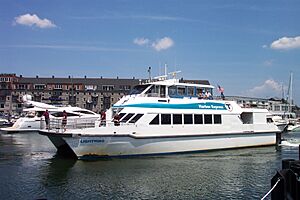
The MBTA boat system has several ferry routes across Boston Harbor. One route connects downtown Boston with the Boston Navy Yard in Charlestown. Other routes are for commuters, linking downtown to towns like Hingham, Hull, and Salem. Some ferries also stop at Logan International Airport.
Private companies operate all boat services under contract with the MBTA.
Services for People with Disabilities
The MBTA offers "The Ride," a special door-to-door service for people with disabilities. This service is run by private companies under contract with the MBTA. In September 2016, the MBTA also allowed "The Ride" users to get rides from Uber and Lyft at a lower cost.
Bicycles on the MBTA
You can usually bring regular bicycles on MBTA commuter rail, commuter boat, and subway lines during off-peak hours and all day on weekends and holidays. However, bicycles are not allowed on the Green Line or the Mattapan Line at any time. Buses with bike racks on the front (including the Silver Line) can carry bicycles. Most MBTA buses now have bike racks.
Bicycles are not allowed at Park Street, Downtown Crossing, and Government Center stations at any time due to how busy they are.
Small folding bicycles are allowed on all MBTA vehicles at all times, as long as they are folded up. You don't need a special permit for your bike, but you must follow the rules.
Most MBTA stations have bike racks, and some have "Pedal & Park" areas that are enclosed and have video cameras for better security. You need a registered CharlieCard to get into these secure areas. All bike parking is free.
Parking at MBTA Stations
As of 2014, the MBTA has parking lots at 103 locations, with space for 55,000 cars. It owns the most paid parking spaces in New England. Parking fees vary, and you can park overnight at some stations for up to 7 days.
You can pay for parking online or by phone at many MBTA lots. Monthly parking permits are also available at a discount. The MBTA also works with companies like Zipcar, providing them with parking spaces at some subway stations.
Hours of Operation
The MBTA usually stops running around 1 a.m. each day. Because the subway system is old and doesn't have separate tracks for express trains, a lot of maintenance work has to be done when trains are not running.
The MBTA tried running late-night service until 3 a.m. on weekends from 2014 to 2016, but it was stopped due to not enough riders and funding issues. In 2019, the board voted to make some changes to allow for future late-night service.
How the MBTA is Funded
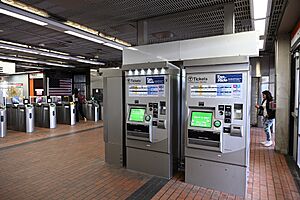
Fares and Payment
The MBTA has different ways to pay for its services. The plastic CharlieCard is used for the subway and bus systems. You can also pay directly with a contactless credit card, Apple Pay, or Google Pay on the subway and buses. For commuter rail and ferries, you use paper CharlieTickets or the mTicket mobile app. You can pay cash on buses, surface trolleys, and commuter rail, but it's not encouraged.
For "The Ride" service, you use an account instead of a physical ticket. Trips are booked in advance online or by phone.
Since June 22, 2020, the Fairmount Line commuter rail has accepted CharlieCards, making it more like a subway line for fares.
The MBTA offers discounted monthly passes for frequent riders. It also has one-day and seven-day passes, often used by tourists.
The MBTA raises fares from time to time to cover costs. A law passed in 2013 limits fare increases to 7% every two years.
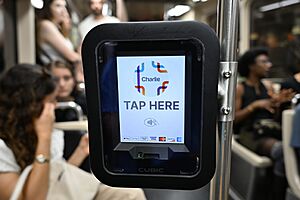
The MBTA is working on a "Fare Transformation" project to make paying easier. This project allows you to use contactless credit cards, Apple Pay, and Google Pay on all subway and bus lines. This system was activated on August 1, 2024. It also allows "all-door boarding" on buses and surface trolleys, meaning you can get on through any door.
Subway and Bus Fares
Most subway trips cost $2.40. Local bus fares are $1.70. You can pay cash on buses, Green Line surface stops, and the Mattapan Line.
Transfers between subway lines are free. With a CharlieCard, you can transfer from a subway to a bus, or from a bus to a subway, by paying the difference in price.
The MBTA also has "Inner Express" and "Outer Express" buses to suburbs, which cost more.
You can buy CharlieTickets from vending machines at subway stations. CharlieCards are also available from these machines since July 2022.
Commuter Rail Fares
Commuter rail fares are based on zones, meaning the price depends on how far you travel from downtown. Rides within Zone 1A (close to downtown) cost $2.40, like a subway fare. Fares for other zones range from $5.75 to $14.50.
Monthly passes are available for all trips and include unlimited rides on the subway and local bus. Some passes also include express buses and ferries.
The MBTA is installing fare gates at North Station, South Station, and Back Bay station to make sure passengers have tickets before boarding. These gates can scan paper tickets, the mTicket app, and contactless CharlieTickets.
Ferry Fares
The Inner Harbor Ferry costs $3.25 per ride. Other ferry routes to places like Hull or Hingham cost more, depending on the distance.
Discounted Fares
The MBTA offers discounted fares and passes for:
- Seniors (65 and older)
- People with permanent disabilities
- People who are legally blind (they ride for free)
- Children under 12 (ride free with an adult)
- Military personnel, state police, and local police/firefighters (ride free with ID)
- Middle school and high school students (with a special "Student CharlieCard")
- Young adults under 25 in certain low-income programs (with a "Youth Pass")
Some colleges also offer "Semester Pass" programs for their students.
MBTA Budget
The MBTA gets its money mainly from a part of the state sales tax, passenger fares, and payments from the cities and towns it serves. It also earns money from parking lots, renting space to stores, advertising, and federal grants.
In May 2019, a report found that the MBTA needed about $10 billion for maintenance. It plans to spend more on capital projects to fix this by 2032.
Future Plans and Projects
Blue Line
There are plans to extend the Blue Line north to Lynn. There's also a plan to extend the Blue Line's southern end westward to Charles/MGH, where it would connect with the Red Line.
Orange and Red Lines
In 2013, MassDOT announced plans for new subway cars for the Orange and Red Lines. These new cars will replace older ones and allow for more frequent service. A Chinese company, CRRC, is building these cars in Springfield, Massachusetts. Deliveries started in 2018, but by early 2023, not all cars had arrived. The MBTA decided to keep some older Orange Line cars as a backup.
The project also includes improving signal systems to make trains more reliable and frequent.
Commuter Rail
The MBTA plans to change its commuter rail system from diesel trains to electric trains. This would allow for more frequent service throughout the day, not just during rush hour. Plans include electric service on the Providence/Stoughton Line and Fairmount Line by 2028–29, and eventually all lines by 2050.
There is no direct train connection between the two downtown commuter rail stations (South Station and North Station). The proposed North–South Rail Link would add a new tunnel under downtown Boston to connect these two parts of the system.
Other plans include extending the South Coast Rail project and possibly extending the Middleborough/Lakeville Line and Lowell Line.
MBTA Property Management
The MBTA owns a lot of land and property. It has a special agency, the MBTA Massachusetts Realty Group, to manage these properties. This agency helps the MBTA work with other groups to use its land, which can bring in extra money for the MBTA. This includes allowing companies to use land for things like power lines or fiber optic cables.
Sometimes, the MBTA sells unused land, such as old streetcar depots or rail yards, through bidding.
How the MBTA is Managed
Structure
In 2015, Governor Charlie Baker created a financial control board (FMCB) to oversee the MBTA and help it become financially stable. This board's term ended in June 2021 and was replaced by a new, permanent MBTA Board of Directors with seven members.
The Massachusetts Secretary of Transportation leads MassDOT and is part of the Governor's Cabinet. The MBTA's daily operations are led by its General Manager, who also oversees all public transit in the state.
The MBTA Advisory Board represents the cities and towns in the MBTA service area. This board has the power to approve or reduce the MBTA's budgets.
The MBTA's main office is in the State Transportation Building in Boston. It also has its own police force, the Massachusetts Bay Transportation Authority Police, which works in MBTA facilities and vehicles.
Board of Directors
The seven members of the MBTA Board of Directors are:
- Thomas P. Glynn, Chair
- Monica Tibbits-Nutt, Secretary of Transportation
- Thomas P. Koch, Mayor of Quincy, Vice Chair
- Robert Butler
- Eric L. Goodwine
- Thomas M. McGee
- Charlie Sisitsky, Mayor of Framingham
- Chanda Smart
General Managers
The current General Manager of the MBTA is Phillip Eng, who started on April 10, 2023.
Employees and Unions
As of 2009, the MBTA had 6,346 employees. Many MBTA employees belong to unions, like the Carmen's Union (Local 589), which represents bus and subway operators. Other unions represent machinists, electricians, and office workers.
Employees are ranked by how long they've worked at the MBTA (their "seniority"). This ranking helps decide things like work assignments and overtime opportunities.
Images for kids


